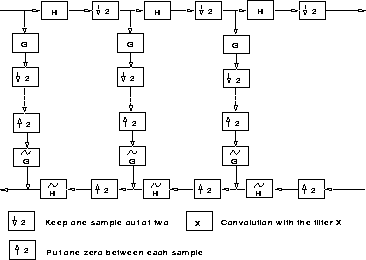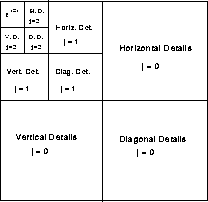 is projected at each step j onto the subset
is projected at each step j onto the subset
 . This projection is defined by the scalar product
. This projection is defined by the scalar product  of
of
 with the scaling function
with the scaling function  which is dilated and
translated:
which is dilated and
translated:
Multiresolution analysis [25] results from the embedded subsets generated by the interpolations at different scales.
A function  is projected at each step j onto the subset
is projected at each step j onto the subset
 . This projection is defined by the scalar product
. This projection is defined by the scalar product  of
of
 with the scaling function
with the scaling function  which is dilated and
translated:
which is dilated and
translated:

As  is a scaling function which has the property:
is a scaling function which has the property:
or

where  is the Fourier transform of the function
is the Fourier transform of the function  . We get:
. We get:

Equation ![]() permits to
compute directly the set
permits to
compute directly the set  from
from  .
If we start from the set
.
If we start from the set  we compute all the sets
we compute all the sets
 , with j>0, without directly computing any other scalar
product:
, with j>0, without directly computing any other scalar
product:

At each step, the number of scalar products is divided by 2. Step by step
the signal is smoothed and information is lost. The remaining
information can be restored using the complementary subspace  of
of
 in
in  .
This subspace can be generated by a suitable wavelet function
.
This subspace can be generated by a suitable wavelet function
 with translation and dilation.
with translation and dilation.

or

We compute the scalar products  with:
with:

With this analysis, we have built the first part of a filter bank
[34]. In order to restore the original data, Mallat uses
the properties of orthogonal wavelets, but the theory has been
generalized to a large class of filters [8] by introducing two
other filters  and
and  named conjugated to h and
g. The restoration is performed with:
named conjugated to h and
g. The restoration is performed with:

In order to get an exact restoration, two conditions are required for the conjugate filters:

Figure: The filter bank associated with the multiresolution
analysis
In the decomposition, the function is successively convolved with
the two filters H (low frequencies) and G (high frequencies). Each
resulting function is decimated by suppression of one sample out of two. The
high frequency signal is left, and we iterate with the low frequency signal
(upper part of figure ![]() ).
In the reconstruction, we restore the sampling by inserting a 0 between
each sample, then we convolve with the conjugate filters
).
In the reconstruction, we restore the sampling by inserting a 0 between
each sample, then we convolve with the conjugate filters  and
and
 , we add the resulting functions and we multiply the result by 2.
We iterate up to the smallest scale
(lower part of figure
, we add the resulting functions and we multiply the result by 2.
We iterate up to the smallest scale
(lower part of figure ![]() ).
).
Orthogonal wavelets correspond to the restricted case where:

and

We can easily see that this set satisfies the two basic
relations ![]() and
and ![]() .
Daubechies wavelets are the only compact solutions.
For biorthogonal wavelets [8]
we have the relations:
.
Daubechies wavelets are the only compact solutions.
For biorthogonal wavelets [8]
we have the relations:

and

We also satisfy relations ![]() and
and ![]() . A large class of
compact wavelet functions can be derived.
Many sets of filters were proposed, especially for coding. It was shown
[9] that the choice of these filters must be guided by the
regularity of the scaling and the wavelet functions.
The complexity is proportional to N. The algorithm provides a pyramid of
N elements.
. A large class of
compact wavelet functions can be derived.
Many sets of filters were proposed, especially for coding. It was shown
[9] that the choice of these filters must be guided by the
regularity of the scaling and the wavelet functions.
The complexity is proportional to N. The algorithm provides a pyramid of
N elements.
The 2D algorithm is based on separate variables leading to prioritizing of x and y directions. The scaling function is defined by:

The passage from a resolution to the next one is done by:

The detail signal is obtained from three wavelets:







Figure: Wavelet transform representation of an image
The wavelet transform can be interpreted as the decomposition on frequency sets with a spatial orientation.